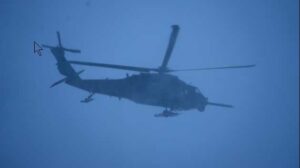
JOINT BASE ELMENDORF-RICHARDSON — Suspended in her parachute harness, an F-16 Fighting Falcon pilot descended toward the frigid Interior Alaska landscape.
In the dead of winter, the temperature plummeted to 35 degrees below zero and cast a blanket of ice fog obscuring the ground. Though the pilot is trained and equipped to survive for a short time in an extreme cold environment, she needed rescue to stave off hypothermia and frostbite.
After safely landing and cutting her parachute loose, the pilot activated her Combat Survivor Evader Locator radio, transmitting a signal to the Alaska Rescue Coordination Center. Knowing it would take significantly longer for a 210th Rescue Squadron HH-60G Pave Hawk to respond from JBER, the 176th Wing search and rescue duty officer dispatched a 210th RQS Detachment 1 Pave Hawk from Eielson Air Force Base southeast of Fairbanks.
As the helicopter made its way to the radio’s GPS coordinates, the HH-60 crew made line-of-sight communication with the fighter pilot on her CSEL to confirm her position. The Pave Hawk landed and delivered a 212th Rescue Squadron combat rescue officer and a pararescueman who made contact with the pilot before ushering her into the helicopter for safe transport back to Eielson.
This realistic but hypothetical scenario highlights the importance of Detachment 1 to the Eleventh Air Force, other U.S. military aviation, and allied aircrews operating in Interior Alaska, providing the air services with all-weather helicopter search and rescue support
Alaska Air National Guard Maj. Seth Peterson, Detachment 1 commander, said the unit comprises several full-time personnel permanently stationed at Eielson Air Force Base.
“We primarily cover the Monday-to-Friday Eleventh Air Force fighter training,” Peterson said. “We are also here and available for civil Search and the [Alaskan NORAD Region] mission. We were stood up in ’94 primarily because of the increasing fighter footprint at Eielson and the need for more coverage in the Northern [Joint Pacific Alaska Range Complex] with a lot of that airspace being north of the [Alaska] Range.”
In recent years, the 18th Fighter Interceptor Squadron, equipped with the F-16, assumed a greater share of the NORAD mission of flying air sovereignty, monitoring and responding to Russian and Chinese military aircraft entering the Alaska Air Defense Identification Zone. Additionally, the 355th and 356th Fighter Squadrons fielded 5th Generation F-35A Lightning II fighters.
Peterson said the detachment operates out of a hangar on the Eielson flightline, which houses the alert helicopter detached from 210th RQS at JBER and serves as a base of operations for the alert helicopter aircrew and pararescuemen on a weeklong tour of duty at the Interior base.
“If a fighter pilot ejects this far into the Interior, that’s where the detachment becomes a critical part of rescue and minimizing that pickup time,” Peterson said.
The HH-60 is the Department of Defense’s only dedicated combat search and rescue helicopter. The Sikorsky Pave Hawk is equipped with specialized rescue equipment, a door-mounted rescue hoist, as well as auxiliary fuel tanks and a refueling probe for taking on fuel in midair from a 211th Rescue Squadron HC-130J Combat King II out of JBER.
Senior Master Sgt. Sean Finney, Detachment 1 senior enlisted leader, said permanent unit personnel serve to keep the Pave Hawk ready.
“Up here, our primary focus is maintenance,” Finney said. “So, when the aircrew comes up, we ensure that the aircraft is flyable for them to perform whatever mission or training they have to do.”
Though the helicopter is staged indoors to keep warm and maximize availability, it is equipped with landing-gear skis and is maintained to fly in extreme cold, all-weather conditions.
Master Sgt. Christopher Fox, Detachment 1 HH-60 lead crew chief, said the unit is manned and equipped to keep the helicopters in top condition.
“We have three crew chiefs, two avionics and a weapons shop Airman up here for maintenance purposes,” Fox said. “So, if it falls under the scope of those Airmen, we can most likely take care of it here.”
During extreme cold, time is of the essence during a training or real-world launch.
“When it’s super cold outside, we will do expedited launches where we pull it outside, spool it up really fast, and take off,” Fox said.
Beyond the nuts and bolts of the helicopter, the detachment also handles the details of managing airfield and airspace considerations from the strategically located Air Force base.
“In addition to the maintenance focus, we do a lot of facilitating for the flying operations here, coordinating with 354th Fighter Wing range personnel and air space schedulers,” Peterson said. “A big part of the formation of the detachment was the availability of base and range support at Eielson.”
The base affords unique training opportunities with 354th FW Survival, Evasion, Resistance and Escape Airmen, both at the Arctic Survival School and the 353rd Combat Training Squadron.
“We train with the Arctic Survival School in the winter,” Peterson said. “It’s a two-way opportunity for them to get helicopter support and train to survivor skills, and we get the opportunity to get survivor radio training.”
The vast military ranges in the Interior provide 210th RQS helicopter crews with valuable training space for aerial gunnery and tactical employment.
“We have the ability to employ weapons in a 360-degree firing fan, so we can tailor our training more dynamically than we can down south,” Peterson said. “It’s a pretty extensive range complex that gives us many opportunities to train.”
Finney said rescue service in the Interior is a unique experience that provides opportunities to work with joint and Total Force partners.
“We work a lot with the active duty and Guard partners here,” Finney said. “In addition to that, we also work with the Army when we have the need. Up here, it’s a tight-knit community where we rely on one another.”
[content id=”79272″]



